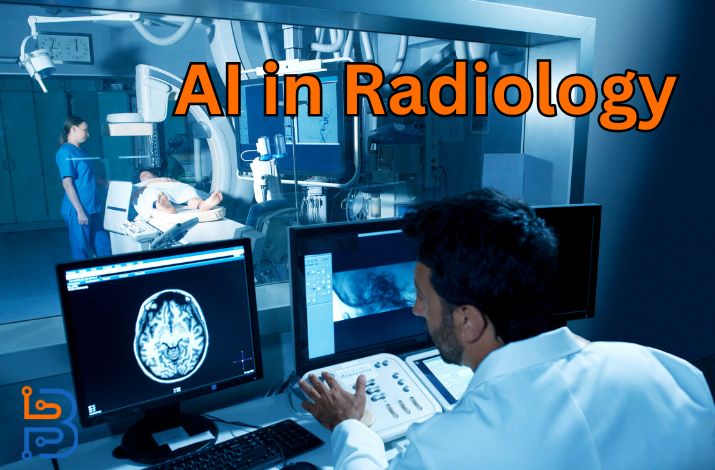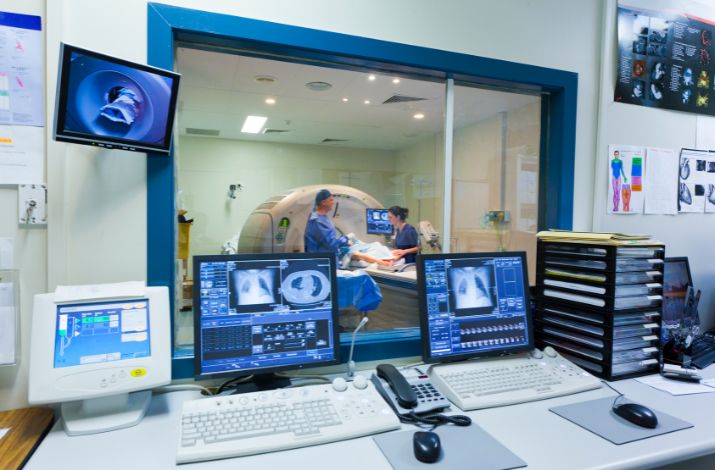AI in Radiology: A Solution to Enhance Radiology Outcomes

Radiology means – images, images, and tons of images!
And we all have seen how a radiologist reads the X-ray, MRI, ultrasound, CT scan, and PET scan with the bare eyes.
But, what if the radiologist overlooks something crucial at the point of care?
The high possibility of a life-threatening situation, right?
To dodge these deadly arrows in the intense healthcare environment, AI is bringing a new era into the radiology profession in order to ensure the patients’ safety and peace of mind for radiologists.
So, whether you’re a radiologist or a tech enthusiast looking forward to gaining some extraordinary and insightful knowledge about AI in radiology, this entire blog is specially curated for you.
But first, let’s understand why radiology craves AI.
The radiology department is always surrounded by other healthcare ecosystems as medical imaging analysis is one of the major tasks to deliver evidence-based and sufficient care solutions.
On a crucial note, confronting tons of workload is a day-to-day task for radiologists. High work burden periodically leads to time-consuming workflows and burnout of radiology staff.
Means, radiology is drowning like a Titanic as a tedious and complex procedure is becoming an iceberg for it.
For instance, here are some reasons that showcase the need for AI in radiology.
1. Tons of medical imaging data
Patient experience, satisfaction, and pleasant outcomes are the things that count in radiology.
That’s the reason, radiologists make immaculate decisions by analyzing large-scale medical imaging data.
However, the process is time-consuming and tedious at the point of care.
What’s more important is that the amount of medical imaging data is surprising and its demand is growing at a tremendous rate.
2. Inefficient workflows
Large-scale data and decentralized ecosystem results in inefficient workflows.
It increases the work burden on radiology staff while at the same time restricting them to create ideal care planning at the point of care.
As a result, it increases the overall operating and resources costs.
3. Low-grade quality care experience
The entire radiology ecosystem is messed-up.
Time-consuming processes, long waiting for getting the ideal care plan, delays in care, and frequently changing care planning are restricting the radiologist to focus on the quality of patient care experience.
The need is rising at a rapid pace for outcome-driven and robust technology solutions to break the roadblocks that are restricting radiologists to provide quality care experience.
AI in radiology is the shining light in the dark tunnel!
It breaks the radiology department’s costly and complex barriers and allows it to thrive hassle-free, with peace of mind.

How AI in radiology enriches the outcomes? Explore its benefits
AI makes the entire radiology to perform faster, accurate, reliable, and efficient tasks in order to scale up the lives of both patients and their care providers.
Here are the benefits of AI in radiology.
1. Assist radiologist in decision making
AI harnesses the true power of medical imaging data.
With large-scale data, it helps radiologists to identify the disease in a faster and more accurate manner along with support in creating a comprehensive and ideal care plan as per the patient’s health condition.
Source: hbr.org
2. Eliminates the possibility of the error
AI algorithms keep their bulls-eye open in medical imaging analysis. It has the ability to capture small details that a radiologist can’t see with bare eyes.
This reduces the chances of human errors which eventually increases patient safety.
3. Lowers the work burden and burnout
AI enables the radiology departments to automate some computer-based repetitive tasks.
As a result,
● It reduces the burnout ratio.
● Allows radiologists to spend more time improving the patient care experience
● Lowers the work pressure and stress
● Speeds up the ecosystem
● Eliminates the manual errors
4. Real-time alerts
It is one of the most beneficial parts of AI in radiology. It continuously analyzes large-scale medical imaging data.
So, when a radiologist inputs the patients’ data into the AI-enabled software, AI compares that imaging data with the existing one and gives a real-time alert if something is suspicious or needs attention.
Means, it also works as a risk assessment tool in the radiology department.
Top 3 use cases of AI in radiology
We always believe in sharing some practical information.
Thus, we connect with the radiology department who is already experiencing the true potential of AI in radiology.
Here is what AI performs in a radiology environment.
1. Assists in brain cancer
“Brain and other nervous system cancer is the 10th leading cause of death for men and women”. (Source)
Classifying brain tumors into different categories and finding the most suitable solution is a major headache in radiology. In addition, the classification process takes almost 40 minutes to complete.
But AI makes the process more than 10X faster as it classifies the tumor categories in just 3 minutes!
Source: cancer.gov
2. Detection of the small or hidden fracture
As we said earlier, at some point, the human eye can’t detect small or tissue cracks in medical imaging.
But using AI in radiology practices, there is no need to worry about this entire mess.
It simply detects minor cracks in the bone or under the tissues.
Here is the study that showcases that AI helps the radiologist with 83% of minor fractures with ease.
Source: Radiology Business
3. In neurological disorders
AI holds the ability to help the radiologist to diagnose the neurological disorder without adding any complexness to the care plan.
It enables them to find or detect the abnormalities in various neurological disorders such as Parkinson’s and Alzheimer’s.
AI-enabled software or tools makes it possible to accomplish it.
Will AI replace radiologists?
Never. And it’s a fact.
AI will not replace radiologists. But will replace their tasks from manual to automated.
Custom healthcare solutions will play a big role in creating AI-powered software for radiologists.
There is no doubt that AI is still in a still development phase.
However, the future is promising as it is going to elevate not only radiology but the entire healthcare ecosystem.






